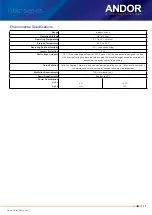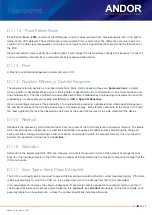
Version 2.0 rev 26 Jan 2017
31
iVac series
APPENDIX D: GLOSSARY
D1 - GLOSSARY
If this is the first time you have used Andor’s CCD, the glossary that follows will help familiarize you with its design
philosophy and some of its key terminology.
D1.1 - CCD
A
C
harge
C
oupled
D
evice (
CCD
) is a silicon-based semiconductor chip bearing a two-dimensional matrix of photo-
sensors, or pixels. This matrix is usually referred to as the ‘
image area
’. The pixels are often described as being
arranged in rows and columns (rows running horizontally, columns vertically). A typical CCD-chip may comprise 256
rows and 1024 columns, or 578 rows and 385 columns.
The CCD in your camera is a scientific slow scan device (in contrast to the fast scan CCD used in video cameras to
capture moving images). An example of a typical layout is shown here:
The
Shift Register
runs below and parallel to the light collecting rows. It has the same number of pixels as a
light-collecting row, but is itself masked, so that no light can fall on it. When light falls on an element, electrons
(photoelectrons) are produced and (in normal operation), these electrons are confined to their respective elements.
Thus, if an image (or any light pattern) is projected on to the array, a corresponding charge pattern will be produced.
To capture the image pattern into computer memory, the charge pattern must be transferred off the chip, and this is
accomplished by making use of a series of horizontal (i.e. parallel to the rows/shift register) transparent electrodes that
cover the array.
By suitable ‘clocking’, these electrodes can be used to shift (transfer) the entire charge pattern, one row at a time, down
into the shift register. The shift register also has a series of electrodes (which are vertical, i.e. parallel to the columns)
which are used to transfer the charge packets, one element at a time, into the output node of the ‘on-chip’ amplifier. The
output of the amplifier feeds the
A
nalog-to-
D
igital (
A/D
) converter, which in turn converts each charge packet into a 16-
bit binary number.










































